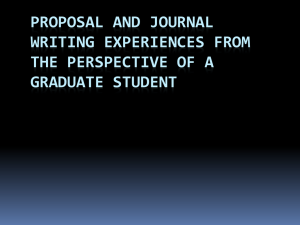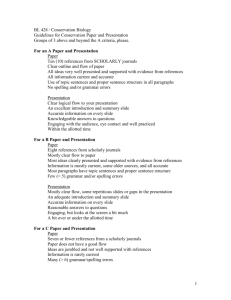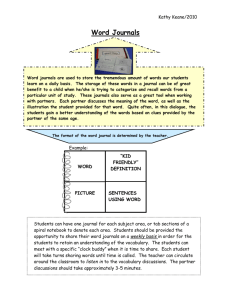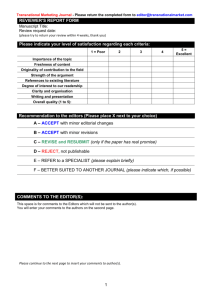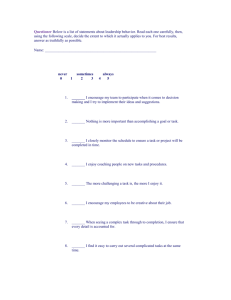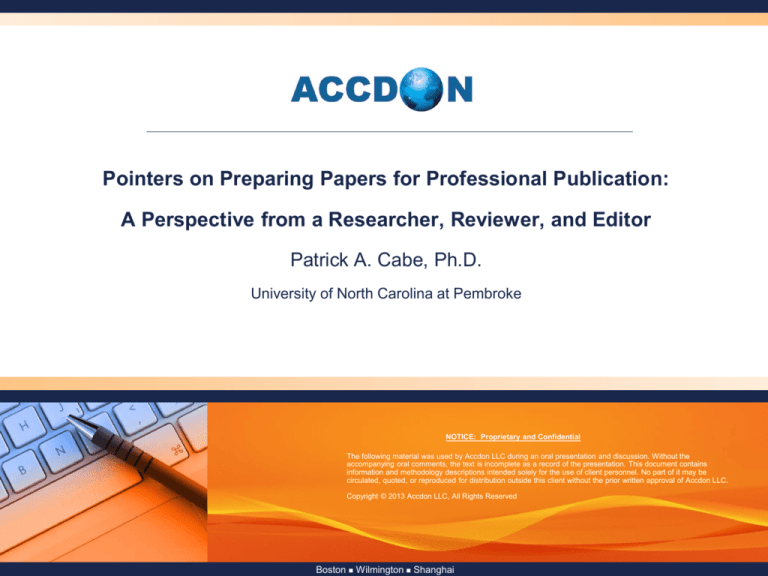
Pointers on Preparing Papers for Professional Publication:
A Perspective from a Researcher, Reviewer, and Editor
Patrick A. Cabe, Ph.D.
University of North Carolina at Pembroke
NOTICE: Proprietary and Confidential
The following material was used by Accdon LLC during an oral presentation and discussion. Without the
accompanying oral comments, the text is incomplete as a record of the presentation. This document contains
information and methodology descriptions intended solely for the use of client personnel. No part of it may be
circulated, quoted, or reproduced for distribution outside this client without the prior written approval of Accdon LLC.
Copyright © 2013 Accdon LLC, All Rights Reserved
Boston Wilmington Shanghai
About US – 关于我们
English Language Editing
论文英语母语化润色
波士顿, 美国
Subject-specific Editing
同行资深专家修改润色
Professional Translation
论文专业翻译
Manuscript Formatting
论文格式整理
中国 上海
2
About US – 关于我们
我们已经成功完成 10,000+ 项目,帮助发表数
以千计的科技论文。
We have assisted many international researchers and
delivered over 10,000 projects in the past three years.
27: 1298-1308 (2012)
9: e1003231 (2013)
97: 1371-1374 (2012)
57: 794-802 (2012)
31: 838–850 (2013)
86: 13841-13842 (2012)
91: 849–862 (2012)
4: 1424 (2013)
47: 946-956 (2013)
134: 10803-10806 (2012)
9: 175-195 (2013)
18: 290–297 (2013)
3
Overview
OUR PRIMARY AIM:
Helping you develop publishable research papers
How to achieve that aim:
Choosing research problems
Writing up your results
Interacting with journals
General tips for improving your writing
Some common writing and style issues
My suggestions come from my
experience as a reviewer, editor,
and teacher.
4
Choosing research problems
What makes a research problem worth working on?
Historical importance – viewed as important over many years,
but still not completely settled
Theoretical importance – tests some proposition derived from
theory (Q: Is the theory itself important?), esp. if the test can
falsify the theory
Practical importance – helps solve/resolve some problem that
has practical significance
Trivial, unimportant, dead-end research problems…
…take just as much time, effort, and resources as good problems
…are harder to get published, especially in high visibility journals
Choose problems wisely!
Research is expensive.
Your time can never be replaced.
5
Choosing research problems
A good general plan for an individual paper:
Experiment 1: Demonstrate the effect
Further experiments: (Partial) replications + extensions to…
…test reliability, robustness of the effect
…probe generalizability of the effect
…resolve possible confounds
…address alternative explanations
The best papers, in the best journals,
often report multiple related experiments
Chain such papers into a series of related papers
6
Writing up your results
Gather your writing tools
Journal guidelines for your target journal
Disciplinary style manual (e.g., APA, AMA, ICMJE)
Dictionaries (standard, specialized)
Thesaurus, synonym finder
General grammar and usage guides
7
Writing up your results
Choosing a target journal: Questions to ask
How important are your results?
Which journals publish results similar to yours?
Your experience
Journals you cite
Does the manuscript fit journal requirements?
Content specificity, journal scope
Single vs. multiple experiments
Length limits
8
Writing up your results
Develop a priority list of target journals, based on:
Acceptance and rejection rates
Impact factors (high impact factor = high rejection rate)
Review and publication lags
Electronic availability/open access
Indexing
Publication costs
Guidance from a professional editing service might be helpful
Consider “aiming high,” submitting to a journal
better than you think will accept your paper.
9
Writing up your results
General pointers: CONTROL THE THINGS YOU CAN CONTROL
ALWAYS follow journal style requirements closely
Papers can be rejected solely for manuscript preparation deficiencies
Content
Style
Language
DON’T RELY ON YOUR SPELLING AND GRAMMAR CHECKER!
Remember – quality of your publication is ultimately YOUR responsibility
NOT the editor's
NOT the reviewer's
NOT the publisher's
Mistakes in the published paper are YOUR mistakes...
…and they are there forever!
10
Writing up your results
Plagiarism, Duplicate publication, Piece-meal publication
Plagiarism: Presenting another author’s writing as your own
Many journals routinely check – the internet makes that easy
Plagiarism can destroy a reputation and career
The ONLY solution is to use appropriate direct quotation or paraphrasing
Duplicate publication: Publishing the same data in more than one paper
Unethical, irresponsible, and a disservice to your discipline and profession
Journals may bar authors who are caught
Piece-meal publication (‘salami slicing’): Publishing parts of a larger research
project in several smaller papers
It is unethical and wastes journal resources
It is a disservice to the discipline
Combine related studies into a single, more comprehensive report
BOTTOM LINE: PRACTICE ETHICAL BEHAVIOR
11
Writing up your results
Title
Aim for
Clarity
Informativeness
Brevity
A big issue is electronic retrieval – that depends on title words
The title is the first filter readers use
to decide if your article is worth reading
12
Writing up your results
Title
Less effective title…
More effective title…
On the generality of the laws of learning
Evolutionary biases on stimuli, rewards, and
conditions for learning
P'
Structure of the Earth’s inner core from
seismic P’ wave reflections
The effect of A in patients with stable
plaques
Effects of A on serum lipids, serum
inflammation, and plaque morphology in
patients with stable atherosclerotic plaques
A generic model for titles:
The effect of variable X on variable Y, under conditions C1…Cn, for
population P
13
Writing up your results
Abstract
Objective: Amplify title
Common problems
Length:
Stay within journal word limits
Subheads often are wasted words (unless required)
References: Generally omit them
Too much detail (e.g., statistical information)
Undefined abbreviations or acronyms
Editorializing
The abstract is the second filter readers use
to decide if your article is worth reading
14
Writing up your results
Introduction
State a clear research question
Use the funnel plan – broad to specific issues
Connections to theory
Connections to existing literature
Clear definition of an empirical gap your results fill
Clearly state your hypothesis(es)
In terms of constructs
In terms of specific operationalizations
Use “if…then” statements
Emphasize novelty and surprisingness of results
Don’t hide the punch line!
You are writing history, not mystery!
15
Writing up your results
Methods
Participants
Identify participant population and sample adequately
Describe
Recruitment (inclusion, exclusion criteria)
Assignment to test conditions
Any motivational considerations
Always acknowledge compliance with ethical standards
Apparatus, materials, instruments: Provide adequate detail, background
Procedure: Clearly describe all steps
Criterion for the Methods section:
Readers could replicate the experiment, given the
Methods section and reasonable common knowledge
16
Writing up your results
Results
Clearly separate chunks of the results (subheads help)
General flow: global to more specific statistical tests
Focus on how statistics address hypotheses
Draw conclusions
“Marginally significant differences” = ZERO differences
Follow journal style for statistical reporting
Figures, tables stand alone -- don’t repeat text material
Statistics are work-horses, not window dressing
17
Writing up your results
Discussion
Use the inverted funnel plan – more specific to broader issues
Summarize the findings
Re-emphasize novelty, surprisingness
Connect results to literature (how results fill an empirical gap)
Connect results to theory
Interpret results (but minimize speculation)
The Discussion section is (often) the third filter
readers use to decide how useful your paper is
18
Writing up your results
Anticipate reviewer objections
Don’t point out…
Instead, talk about…
Limitations on results
Boundary conditions of effects
Limitations due to confounds, artifacts
Alternative explanations
Limitations of methods
Constraints of methodology
Limitations on generalizability
Parameters of generalizability
Suggest possible practical applications
Suggest future research directions, next steps: Some possibilities…
Change the IV (including parametric changes)
Change the DV
Change conditions
Change the population (cross-cultural studies are immediate possibilities)
19
Dealing with journals
Some general points:
Journals want to ACCEPT papers, not reject them. WHY?
Demand
Around 25,000 peer-reviewed journals
Publishing 1 - 2 million articles a year
Many publishers are in business to make a profit
Manuscripts are free raw materials (but expensive to you!)
Much labor is donated (editors, reviewers)
Institutions may subsidize editor efforts
KEY POINTS TO REMEMBER:
Follow journal guidelines for submission EXACTLY
Practice good language skills
Make your paper as near perfect as you can (but expect to make revisions)
Make it easy for the reviewers and editors
to like your paper
20
Dealing with journals
Reviewer Context
Volunteer labor
Try to be fair
Competition for their time
Likely to look for shortcuts
What looks good is good
Known is better than unknown
News is better – surprise, novelty
Using this perspective
Recommend reviewers
Highlight importance relative to theory, existing knowledge,
practical problems
Highlight novelty, surprisingness
Perfect language, perfect style, perfect mechanically
21
Dealing with journals
Questions reviewers want to see answered
•
Is there a clear research question? Why is it important?
•
Does the work fill a gap in the existing literature?
•
Is the logic of the research adequate to answer the research question?
•
Is the methodology appropriate for the research question?
•
Do the results adequately address the hypotheses?
•
Are interpretations consistent with the design, the data, and the literature?
•
Is the research explained clearly and understandably (language, readability)?
•
Are the results novel, surprising?
•
Does the paper conform to journal style guidelines?
The confused mind says “No!”
Don’t confuse reviewers or editors.
22
Dealing with journals
Submission cover letters
Some guidelines (electronic submission portals often ask about these issues)
Use the editor's name and the title of the journal
Include manuscript details (title, word count, numbers of figures and tables)
BRIEFLY, tell why the paper is worth publishing (importance, novelty,
surprisingness, robustness)
Recommend preferred, non-preferred reviewers: Tap your network
Affirm the paper is not under consideration elsewhere
Affirm conformity with ethical requirements (use available protocols)
Acknowledge potential conflicts of interest
Include contact information for corresponding author
23
Dealing with journals
Submission cover letters
Potential problem areas to avoid
Using a form letter
“Dear editor” (editors have names!)
“Your honored journal” (it has a title!)
Including too much information about the content of the
paper (don’t copy-and-paste the abstract!)
Leaving out administrative and mechanical details (help
the editor manage the manuscript!)
Using an obsequious, pleading tone (respect yourself
and your work!)
24
Dealing with journals
Dealing with the review process
Initial contacts
It's okay to contact editors, especially about paper appropriateness
DO recommend reviewers in your cover letter
People who know you and your past work
People whose work is related to your own
Mention people who you would prefer not to be reviewers
Waiting…the hard part!
Give the reviewers and editor time to do their work
If the time seems excessive, inquire politely
25
Dealing with journals
Manuscript
Decision
Accept as
submitted
Celebrate
wildly!
Tell your
Supervisor!
Call the Nobel
Foundation!
Revise and
resubmit
Reject
Take a deep
breath!
Rant and
rave!
Read all
comments
carefully
Take a deep
breath!
Revise the
paper
Read all
comments
carefully
Write
response
letter
Revise the
paper
Resubmit
26
Submit
elsewhere
Dealing with journals
Response letters with re-submissions
[Google search: "how to respond to manuscript reviewers" yielded > 2 million hits]
DON’T WRITE IN ANGER! DON’T ATTACK THE EDITOR OR REVIEWERS!
Common elements of response letters
Express appreciation for the reviewer’s time and effort
Answer every point every reviewer makes
Indicate where revisions have been made and their nature
Organize your responses (possibly parallel columns)
Categories of response to reviewer comments
"I see the reviewer’s point and have revised the ms. in the following way…“
"I do not agree with the reviewer, for the following reason(s), and have left the
original wording….“
"I don't understand the reviewer's point and therefore don't know what
changes to make…“
The response letter is as important
as the revised manuscript!
27
Some common writing and style issues
Mostly language (grammar, syntax, and spelling) problems
Long sentences, long paragraphs, big words
Check average sentence length – aim for about 15 – 20 words/sentence
Check readability: AS A ROUGH GUIDE, aim for…
Flesch score ca. 30 (lower is harder to read)
Flesch-Kincaid > 16 (higher is harder to read
Use good judgement about these numbers
Alternate short, simple sentences with longer, more complex ones
28
Some common writing and style issues
Mostly language (grammar, syntax, and spelling) problems
Passive voice sentence construction
Example: “It has been established that…” (by whom??)
Passive voice…
often leaves agent ambiguous
often uses more words
Prefer active voice: “Past researchers have established…”
Okay to use personal pronouns (I, we) to achieve active voice
29
Some common writing and style issues
Mostly language (grammar, syntax, and spelling) problems
Unclear pronoun antecedents
Example: “Participants completed three tests. They indicated…”
Generally, pronoun refers to the most recently occurring noun
When in doubt, repeat the noun
Articles (a, an, the)
“a” and “an” are used to indicate one of many possible instances
“a” where the noun begins with a consonant sound
“an” when the noun begins with a vowel sound
“the” is used to indicate a particular instance
30
Some common writing and style issues
Mostly language (grammar, syntax, and spelling) problems
Number disagreement (subject-verb, noun-pronoun)
Subject-verb: singular subject, plural verb; plural subject, singular verb
Examples:
“The set of responses include…” (subject is “set,” not “responses”)
“The colors of the rainbow is…” (subject is “colors,” not “rainbow”)
The verb must agree with the subject, not just the closest noun
Noun-pronoun: singular noun, plural pronoun; plural noun, singular
pronoun
Examples:
“Everyone forgot their notebook” (“everyone” is singular; “their” is
plural)
“Neurons are polar units and it fires in only one direction…” (“neurons”
is plural; “it” is singular)
The pronoun must agree with the actual referent, not just the closest
noun
31
Some common writing and style issues
Mostly language (grammar, syntax, and spelling) problems
Punctuation, especially commas
Commas can completely change the sense of a sentence
Example:
> “The panda eats, shoots, and leaves”: Now, remove the commas!
> “The panda eats shoots and leaves”
> Removing the commas turns VERBS (“shoots,” “leaves”) into
NOUNS
> English has many words that can be both nouns and verbs!
Example:
> “Woman, without her man is nothing.” (Put in a second comma!)
> “Woman, without her man, is nothing.” OR…
> “Woman, without her, man is nothing.”
32
Some common writing and style issues
Comma splices
Joining two complete sentences with only a comma to separate
them
Use a semi-colon, or a period and start a new sentence
Incomplete sentences
Lack a subject or predicate
Often dependent clauses that should be attached to preceding
sentence
Example: “The data showed an effect of the IV. Which supported
the hypothesis.”
Reword to add a subject or predicate, or connect the clause to
the preceding sentence
Verb tenses
Present tense to describe current states of affairs, circumstances
Past tense to describe completed actions, past circumstances
33
Some common writing and style issues
Mostly language (grammar, syntax, and spelling) problems
Spelling problems
Homographs: words spelled the same, sound different, different meaning
Examples: lead (guide, metal); bass (voice, fish); does (performs, deer)
Homophones: spelled differently, sound the same, different meaning
Ex: read/reed; by/buy; sight/site/cite; rain/rein/reign; there/their/they’re
Confusable words
Ex: affect/effect, advice/advise, adapt/adopt, and many more!
Words with multiple meanings
Ex: knot, bank, fine
Irregular verbs (is, was, were; go, went)
Irregular noun plurals: mouse, mice (but not house, hice)
Phonemic spelling (“meens” for “means;” “fotograph” for “photograph”)
Typos: missing letters, letters in the wrong order, added letters
A word may be correct in one context and misspelled in another
Spell checkers will not catch those!
34
Some common writing and style issues
Mostly language (grammar, syntax, and spelling) problems
Figures of speech, slang, allusions, idioms, neologisms
Figures of speech: metaphors, similes – intrinsically ambiguous
Example: “Replication is the lifeblood of science”
In what ways might this be true or false?
Slang: ambiguous, because it depends on time and place
Allusions: ambiguous, because they assume relevant knowledge
Idioms: ambiguous, because they are often culturally-dependent
Neologisms: invented words not easily understood
Undefined abbreviations, acronyms
35
Some common writing and style issues
Mostly style problems
Reference citation placement – often unclear connections to content
Reference formats – in the text, in the reference list
Paragraph indentation – usually at least a centimeter
Hedged words (in quotation marks) – lead to ambiguous readings
Inclusive, non-sexist language – becoming the common usage
Text justification – prefer flush-left
Nested, back-to-back parentheses – generally, don’t use this format
Numbers to begin sentences -- use number words
36
Some common writing and style issues
Mostly logical problems
Problem words: cause, prove
Anthropomorphizing nouns (e.g., “the results found that…”)
Pilot study vs. pre-test
Ambiguous synonyms – use the same word for the same concept
37
General tips for improving your writing
Writers write
It isn’t easy for anyone!
…even native speakers
…even professional writers
YOU ARE IN GOOD COMPANY!
Build regular, specific writing time into your schedule
Outlines help keep your writing projects on track
If it's important to you, you'll do it
38
General tips for improving your writing
Writers revise…and revise…and revise
NEVER, EVER SUBMIT A FIRST DRAFT!
Even for skillful writers, "good enough" ISN'T!
I rewrote the ending of Farewell to Arms, the last page of it, 39 times
before I was satisfied.
Ernest Hemingway
Don’t depend on the journal editor to polish your writing – submit your
BEST
BUT DO GET HELP AS YOU NEED IT
…from sympathetic colleagues
…from professional editing services
39
General tips for improving your writing
Writers study writing
Study grammar, spelling, sentence structure, organization, etc., etc.
Build your vocabulary
Study great writing – beyond reading it, ask what makes it great as writing
40
General tips for improving your writing
Writers share their writing
Be willing to take constructive criticism
Ask colleagues to read and discuss your writing with you
Volunteer to read their work in return
Use editorial services for special assistance
Writers talk to readers
Here, I have in mind potential editors and reviewers
Become known to your research community – NETWORK!
Writers think like readers
Take the perspective of your intended reader when you write
Particularly important for multi-disciplinary journals
41
联系我们
E-mail:
chinasupport@letpub.com
电话:
021-33311101,021-34243335,021-34243363
传真:
021-51062021
网址:
www.letpub.com.cn
地址:
上海市斜土路2601弄嘉汇广场T1幢31楼CD座07室
邮政编码:
200030
42

